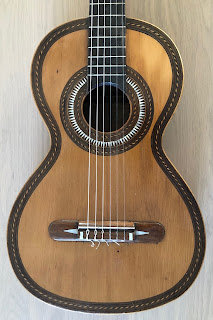This guitar wasn't in a bad condition apart from a loose
back and rusted tuners with knobs breaking off.
Mounting the bindings on the back is the last process
before the relacquering of the guitar can start.
Possibly Brasilian rosewood as it was readily available
in those times but I'm not sure about that. When you
really need to sand down parts, the typical smell betrays
the use of it but that wasn't necessary here.
It is fine that people are doing their investigations
around some guitar builders and that also counts
for the various labels used along the timeline.
Here above the label in the condition as it is
in the guitar.
A better example to make your research. This label
is called the "resonador" label of which the "medaillon"
on the left attests. Used between 1898 and 1902.
The back that was in a good condition but a bit
strange treated was a small crack at the bottom
the right. I made it thinner but left it that way.
The lowest transverse bar was missing. I've added
a new one of course and shortened the others a bit.
Under higher temperatures they tend to expand
and can damage the sides.
Here the clamping of the back can be seen. The
original inner glue lining was missing. I made a new
one but I divided the strip into small blocks in order
to prevent too much deforming of the sides as I wanted
to make a slight neck reset as well. Correcting the
sides continuously while gluing is a must then.
Therefore the use of rope or elastics wasn't the
way to go for.
There are more of these guitars obtainable but often
they lack the original bridge. That is still here.
And the two abalone inserts on the string tie block
still can be found on a lot of Telesforo Julve guitars
who took over business from Salvador Ibanez e Hijos.
This one is made out of Brasilian rosewood.
Just to show that there is minimal fretwear. I presume
this guitar coming out of the large guitar collection
of Mrs. Pratten as other instruments also were offered
with that origin. bought, but it never came to a
good restoration. Original frets refreshed.
The reverse way of mounting the tuners: The wurm
before the wormwheel as was common until about
the period 1910 - 1920. A rather narrow nut but you
could say it "belongs" to the smaller scale this guitar
is provided with. Remarkable is that guitars with the
label of Francisco Pau or Jaime Ribot often are
showing the same headstock form.
The G-tuner has a slight bow in it but as it is a
lot older it might be too fragile to correct that
and to be honest, in use you hardly experience it.
And here the situation where we came from....
The typical way of constructing the outer heel: The use of
a softer wood in order to speed up building process. The
ebony covering of the heel is not original as a small part
of the heel was damaged and the original plate was
missing. Therefore slightly thicker executed.
These ornamentions probably could have been
done by a third party. The fingerboard has a been
hardened with a liquid used for rotten window frames.
The tuners on this guitar work the normal way and the
copper shafts were the ones the most used at that time.
A newly added binding around the back.
The multiple layers of bindings can be studied here.
This guitar has a nice playing action and could
even be lowered but that wouldn't be my advise!
Even better for the highest strings!
The knobs that are riveted on the axes.
The head also decorated with mother of pearl inlays.
The sides still in a good condition.
It must have been a lot of work especially in those times.
Most likely done in another factory who supplied them
to various guitar builders in Valencia
A nice shot of the right upper bout.
The picture has been added as if it looks there was a crack
but cracks always leave their mark in the varnish layer es-
specially after some time.
The final layers of French polish have been added but
another layer with a lot of alcohol in it is even augmenting
the glance of French polishing and certainly after some
extra polishing with a polishing liquid.
The copper shafts that aren't solidly made. And of
course the newly made knobs for this guitar.































Geen opmerkingen:
Een reactie posten